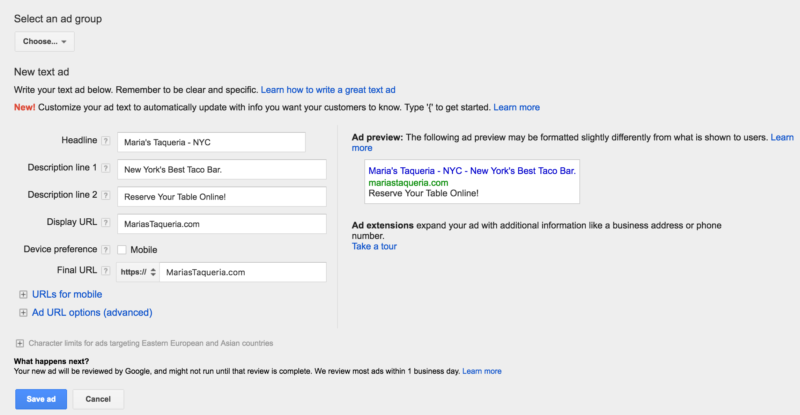

We’re living in a digital age. Billboard, TV, radio and print advertisements are becoming less and less effective with every passing year. In 2015, $58 billion (yes, with a ‘b’) was spent by businesses, just like yours, on digital advertising. This year, we’ve already seen some impressive online campaigns. So, clearly, 2016 is set to be the year of integrated online advertising initiatives across the restaurant and bar industry.
Yes, you’re doing a great job posting updates to your social media channels, but the reality is this—it’s simply not enough anymore. If you’re not paying for ad placements across the internet machine, you’re limiting your reach and thus limiting your potential revenue.
As the owner (or manager) of a bar or restaurant, you should be making an active effort to advertise online in the places your potential customers frequent daily. Here’s how to advertise your bar or restaurant on five popular websites: Google, Bing, Facebook, Instagram and Twitter.
Google ads can be a highly effective way to advertise your restaurant or bar. The first thing I do when I’m searching for a new restaurant (usually to try for date night) is consult my most informative friend, Google. Google ads work particularly well for restaurants that don’t rank well in Google’s organic search results. Why? Because you can pay to bring your business to the very top of the page.
Google allows users to bid on the keywords that people are searching for. Try bidding on keywords like “restaurants near me,” “best restaurants (insert city),” or “Italian restaurants (insert city).” Bidding on competitors’ brand names can be highly effective, as well. Let’s say a user is searching for Charlie’s Steak House, but the first thing he sees on Google is an ad for Norman’s Steak House, instead. This user’s choice of restaurant is now highly susceptible to influence from your ad. Poaching customers is GOLD. But be careful—sometimes, advertising on a competitor’s brand name will start a bidding war. Why? Because these competitors could start bidding on your restaurant’s name, as well.

Google will charge you on a “pay per click” pricing model. Adwords is a live auction, so your bid on each keyword will determine where you show up on the search page. If you’re not sure where to set your bids, start low (around $1.50). Then, you can adjust them as you see fit. It’s fairly easy to set up these digital advertising techniques for your own bar or restaurant—start by signing up for a Google Adwords account at Adwords.com.
Bing ads are very similar to Google ads in their appearance, setup and execution. Many people search on Bing because it’s the default browser on their computers, mobile devices or tablets. Bing users tend to be a little bit of an older demographic, so if this is your target market, Bing might be a great place to start advertising.
In addition, Bing is generally a less competitive place to advertise. This is because there are less advertisers using Bing compared to Google, so the average “cost per click” tends to be cheaper and click-through rates tend to be higher.
Start out by setting your bids on Bing at 25% lower than a bid you might set on Google for the same keyword.
Set up your Bing ads accounts at ads.bing.com.
Posting regularly on your bar or restaurant’s Facebook page is great, but you can raise the bar (no pun intended) further by paying for your ad to show up in users’ newsfeeds. And here’s a fun fact—the Facebook algorithm has recently changed, so now your organic (regular) posts are not even being shown to all of your followers. To combat this change, you can start paying for spots in users’ newsfeeds. What’s even more appealing, however, is that you can advertise not only to people who have already liked your page, but also to virtually anyone who has a Facebook account.
Facebook is the ultimate advertising tool because: (a) you can slice and dice users virtually any way you want, and (b) only advertise to the buckets you self-create. For instance, I could advertise to males, who live in Boston, are between the ages of 28-40, and who have incomes higher than $100k/year. Furthermore, I can also serve my ads to those who have an interest in French cuisine. Cool, right?

Remember—the more filters you apply to your Facebook ads, the less people who will be eligible to see your ads; the key is finding the sweet spot. Be careful not to drill down your audience to be so limited that only a dozen folks are seeing your ads. Likewise, you shouldn’t target the entire United States in your Facebook ads campaign. You’ll burn through cash quickly, and your ads won’t be showing to the right people.
Instagram ads are run through the Facebook advertising platform, with identical targeting options. In fact, the default setting when you start a Facebook campaign is that Instagram will also be targeted, unless you opt out. I suggest not opting out, as Instagram is a great platform to increase brand awareness for your restaurant. Just make sure to connect your Instagram account to your Facebook page before you start.
For both Facebook and Instagram visuals, try posting pictures of your most aesthetically pleasing dishes. In the text of your ads (there’s a special place dedicated to this, not within the photo itself), be sure to include your restaurant or bar’s name and location. This might seem intuitive, but sometimes people forget!

It’s also advisable to keep text out of the actual photo of your ad. Leave the text for the designated text box that Facebook and Instagram allow advertisers to utilize. The reason for this is because social media ads perform better if they are more seamlessly integrated into social feeds, looking more like an organic post rather than an advertisement. If you don’t decide to take my advice and end up using text in your photo, according to Facebook’s advertising policies, the photo may not include more than 20% of text in the image.
On both Facebook and Instagram, you can also use videos as visuals, which can be very effective. If you do choose to use a video, though, be sure the video can be understood without audio. Most Facebook users do not turn on their volume to watch videos, so whatever script there may be in your ad likely won’t be heard by many people. Also, make sure to include your restaurant’s name and location in the first 10 seconds of the video, in case the user doesn’t watch the entire video.
Facebook and Instagram ads have an automatic bidding feature (which I recommend you take advantage of). Simply set your desired budget, and Facebook will set your bids at a reasonable price, based on your given budget.
To set up a Facebook and Instagram advertising account, go to facebook.com/business/products/ads.
Twitter ads are used by advertisers to promote their tweets, promote their accounts, and promote trends. In short, Twitter is good for building an audience (your Twitter followers), generating more website traffic, and increasing brand awareness.
Twitter ads are great because, like Facebook, you can get very granular in your targeted audience. To start, try targeting Twitter users in the city or town your bar or restaurant is located in. To get more granular, target people who have an interest in “dining out” or “fine dining.” You can even target users who have an interest in “Cajun and Creole,” “foodie news,” or “liquor and spirits.” Remember, the more granular you get, the smaller you’re making your audience. Being granular is a good thing, unless you’re cutting off valuable traffic. So, be careful not to cut out potential new business.
I recommend using the automatic bidding feature for Twitter, as well. Your bid will be optimized to get the best results at the lowest price within your given budget.
Twitter ad accounts can be set up by visiting ads.twitter.com.

Twitter is also a great platform to launch competitive advertisements. Why? Because you can target the handles (usernames) of your competitors. This means your ad will be eligible to serve to anyone who follows your competitors on Twitter. Let’s say I’m McDonald’s. I could target Burger King’s Twitter followers. Nifty, huh?

There’s only one thing that gets a little tricky with online advertising: The rules change all the time. Most platforms will inform you when they mix things up, but try to keep up to date with the latest online advertising guidelines to stay ahead of any changes to your ads.
This digital world of ours is full of opportunities for getting your bar or restaurant’s name out there—we see more and more each day. But with all this great opportunity and innovation comes increased competition and more room to slip between the cracks if you don’t keep up. So, use these online advertising tips to reach more potential customers and start bringing in more sales.
Are there any online advertising strategies you’ve found successful for your bar or restaurant? Let us know in the comments below!
Schedule 15mins to chat with a product specialist
Start a FREE Trial Today! BevSpot offers full product education and account setup for all customers! No card Information needed!
